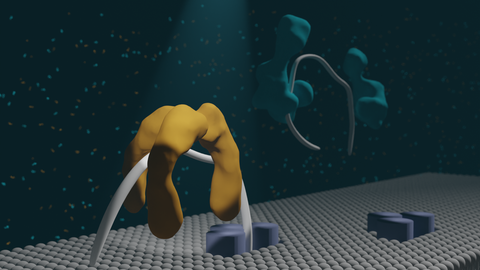28.02.2022
Arbeiten ohne Energie: B CUBE-Forschende erklären die Thermodynamik von Chaperonen im periplasmatischen Raum

Ein 3D-Bild, das die Bindung des OmpX-Proteins (weißer Strang) mit seinen beiden Chaperonen (in gelb und dunkelgrün) zeigt.
Chaperone verhindern, dass sich komplexe Proteine vorzeitig falten. Um zu funktionieren, benötigen die meisten von ihnen Energie in Form von ATP. Einige Chaperone müssen jedoch ohne ATP arbeiten. Ein Forschungsteam am B CUBE - Center for Molecular Bioengineering der TU Dresden hat mit Hilfe von Einzelmolekül-FRET und FCS gezeigt, wie Chaperon-Protein-Komplexe thermodynamisch fein aufeinander abgestimmt sind, um zu verhindern, dass bakterielle Proteine der äußeren Membran in einer ATP-freien Umgebung falten und aggregieren. Die Ergebnisse wurden in der Zeitschrift PNAS veröffentlicht.
Proteine erfüllen in den Zellen ganz bestimmte Funktionen. Jedes Protein hat eine einzigartige dreidimensionale Struktur, die seine Funktion unterstützt. Je länger die Proteinkette ist oder je mehr einzelne Untereinheiten das Protein hat, desto schwieriger ist es, dass es sich in eine korrekte dreidimensionale Struktur faltet. Es gibt eine spezielle Klasse von Proteinen, die sogenannten Chaperone, die anderen Proteinen dabei helfen, sich richtig und an ihrem vorgesehenen Platz in der Zelle zu falten. So müssen beispielsweise Proteine, die in Membranen eingebettet werden sollen, daran gehindert werden, sich innerhalb der Zelle falsch zu falten, und können erst falten, wenn sie an der Membran angekommen sind.
Ein Ort ohne zusätzliche Energie
Die Interaktion zwischen Chaperonen und Proteinen erfordert Energie und wird in der Regel durch Energiemoleküle, das ATP, angetrieben. Einige Chaperone müssen jedoch auch ohne diese Energiemoleküle mit Proteinen interagieren. In dem speziellen Raum zwischen der inneren und der äußeren Bakterienmembran, dem sogenannten periplasmatischen Raum, arbeiten Chaperone und sorgen dafür, dass Proteine entfaltet und löslich bleiben, ohne dass zusätzliche Energie zur Verfügung steht. Forschende des B CUBE haben eine Strategie entwickelt, um die Interaktion von OmpX, einem bakteriellen Außenmembranprotein, und zwei wichtigen Chaperonen, Skp und SurA, zu analysieren. Sie entdeckten, wie diese Chaperone verhindern, dass OmpX sich falsch faltet und aggregiert.
Außenmembranproteine wie OmpX sind entscheidend für das Überleben von Bakterien. Sie sorgen für die Adhäsion, die Nährstoffaufnahme, die Wahrnehmung der Umwelt oder die Interaktion mit Chemikalien und Toxinen. Als solche sind sie auch eines der Ziele von antibakteriellen Medikamenten. „Diese äußeren Membranproteine sind sehr klebrig. Sie neigen dazu, sich aneinanderzulagern und zu verklumpen. Sie müssen jedoch ungebunden und entfaltet bleiben, bis sie in die äußere Bakterienmembran eingebaut werden können", erklärt Prof. Michael Schlierf, Forschungsgruppenleiter am B CUBE und Leiter der Studie.
smFRET als Werkzeug für dynamische Strukturbiologie
Um die dynamische Struktur von OmpX und den Chaperonen zu charakterisieren, sezte das Team von Prof. Schlierf den Einzelmolekül-Förster-Resonanz-Energie-Transfer (smFRET) ein. Dabei werden fluoreszierende Marker verwendet, um den Abstand zwischen Teilen eines einzelnen Moleküls im Nanometerbereich mit einer Zeitauflösung von bis zu Nanosekunden zu messen. Mit smFRET konnte das Team beobachten, wie die Bindung an Chaperone die Dynamik und die Struktur von OmpX verändert. „Der Aufbau von Experimenten mit Außenmembranproteinen ist schwierig. Wir haben viele Parameter sowohl für die Chaperone als auch für OmpX sorgfältig optimiert, bis wir diese Experimente durchführen konnten“, fügt Dr. Neharika Chamachi, eine Hauptautorin der Studie, hinzu.
Verhinderung der Faltung durch Expansion
Das Team hat herausgefunden, dass die beiden Chaperone die Aggregation von OmpX verhindern, indem sie das unstrukturierte OmpX auf andersartige Weise expandieren. Weder Skp noch SurA nutzen die Energie des ATP, so dass die Bindung mit den Chaperonen unterschiedliche thermodynamische Eigenschaften ausnutzt. Skp bindet das Protein auf eine bestimmte Weise entlang der Kette. Die Interaktion mit SurA hingegen war außerordentlich dynamisch. Es band und löste das Protein ständig auf scheinbar unspezifische Weise.
„Diese unterschiedlichen Bindungsarten konnten auch durch enthalpische und entropische Beiträgen quantifiziert werden, die wir durch temperaturabhängige Messungen bestimmen konnten", erklärt Dr. Andreas Hartmann, ein weiterer Hauptautor der Studie. Durch die Feinabstimmung von Enthalpie und Entropie sind die beiden Chaperone in der Lage, OmpX expandiert zu halten und seine Aggregation in einer Umgebung zu verhindern, in der die zellulären Energiemoleküle fehlen. Gleichzeitig bleibt OmpX dynamisch und kann sich für den nächsten Faltungsschritt entbinden.
Wechsel unter Stress
Das Team untersuchte auch die Protein-Chaperon-Interaktion unter Stressbedingungen. Wenn Zellen schwierigen Bedingungen ausgesetzt sind, z. B. Temperaturschwankungen oder schädlichen Chemikalien, wird im Allgemeinen auch der Weg zur Faltung der äußeren Membranproteine beeinflusst. Unstrukturierte OmpX-Moleküle werden nicht mehr chaperoniert und neigen dazu, sich aneinander zu lagern und große Aggregate zu bilden. Die Dresdner Gruppe zeigte, dass unter solchen Bedingungen sowohl Skp als auch SurA ihre Aufmerksamkeit von den einzelnen OmpX-Molekülen auf die aggregierten OmpX-Proteine lenkten und begannen, die Aggregate zu zerlegen. Mehr noch – Skp und SurA wirkten unter diesen Bedingungen synergistisch.
„Unser smFRET-Assay ermöglicht es uns, die Wechselwirkungen zwischen Chaperonen und Membranproteinen zu charakterisieren. Wir glauben, dass er auch für andere Gruppen nützlich sein kann, die ähnliche transiente Wechselwirkungen charakterisieren wollen, die nur bei sehr niedrigen Proteinkonzentrationen gemessen werden können", schließt Prof. Schlierf.
Originalveröffentlichung
Neharika Chamachi, Andreas Hartmann, Mai Quynh Ma, Anna Svirina, Georg Krainer, Michael Schlierf: Chaperones Skp and SurA dynamically expand unfolded OmpX and synergistically disassemble oligomeric aggregates. PNAS (Februar 2022)
Link: https://doi.org/10.1073/pnas.2118919119
Wissenschaftliche Ansprechpartner:
Prof. Michael Schlierf
Research Group Leader
B CUBE - Center for Molecular Bioengineering
+49 351 463 43050
